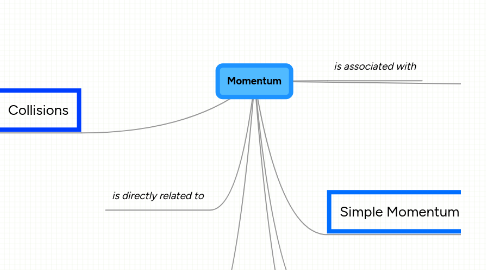Momentum
by Kerwynus Bahadur


1. Collisions
1.1. Completely Inelastic
1.1.1. “Perfect Sticking”
1.1.2. Conservation of only momentum
1.1.3. m1v1i +m2v2i = (m1 +m2 )vf
1.2. Inelastic
1.2.1. “Sticky” but the bodies do not stick together
1.2.2. Conservation of momentum only
1.3. Elastic
1.3.1. “Perfect bouncing”
1.3.2. Conservation of kinetic energy and momentum
1.3.3. m1v1i +m2v2i = m1v1f +m2v2f
2. Solving for quantities in collisions
2.1. Sketch before and after diagrams
2.2. Collect and organize data of all the masses and velocities
2.3. Set the sum of momenta of the two before the collision = to the sum of the momenta after the collision
2.4. Write one equation for each direction
2.5. If perfectly inelastic set final velocities equal
2.6. If perfectly elastic set final kinetic energy equal to initial kinetic energy
2.7. Solve for unknown quantities
3. is directly related to
4. Linear Momentum
4.1. vector Quanity having same direction as the velocity
4.2. The vector of p = mass times the vector of velocity
4.3. The momentum and changes of two objects are always equal and opposite
5. Motion
5.1. Newton's 1st law of motion
5.2. Newton's 2nd law of motion
5.3. Newton's 3rd law of motion
5.4. Dynamic Systems
5.4.1. which include
5.4.1.1. rockets, garden sprinklers
6. Simple Momentum
6.1. Vector quanity
6.2. For momentum to be Conserved
6.2.1. Constant Magnitude
6.2.2. Constant Direction
6.3. Mass and velocity involved
6.4. Conservation
6.4.1. If no external force acts on system, the initial momentum of the system is equal to the final momentum of the system.

